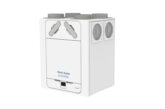
Christian Rehn, National Design and Project Manager of National Ventilation, explains how ventilation system design can be made simple.
As housebuilding in the UK continues unabated, electrical contractors wanting to grow their ventilation business are primed to take advantage of this increasing market. But in order to win projects they might not have won before, contractors will need to embrace technologies like Mechanical Ventilation with Heat Recovery (MVHR). So, what do you do if you are not sure how to specify this technology but would like to expand your business?
With housebuilding on the up there is a real opportunity for small to medium-sized electrical contractors to take advantage of this growth through projects in small housing development plots. However, when it comes to new build ventilation projects contractors will need to be familiar with the design and specification of technologies such as MVHR.
A major hurdle here is that specialist knowledge of the equipment or software programmes is often needed to correctly calculate the resistance and pressure in the system over a given length of ducting. This may be daunting for some contractors who may not know where to start when asked to design an MVHR system and, as a result, could potentially lose the business.
Luckily, there are design services available, such as the free service National Ventilation supplies, to help electrical contractors secure these projects and grow their business. Through its close relationships with electrical wholesalers National Ventilation specialises in offering a full design service for self-build and design & build projects to help contractors win business they might otherwise have walked away from.
The service will supply a full design and quotation, including unit calculations, a full kit list and recommended duct routes.
Design
So what steps are needed to design and specify a ventilation system? The first step in designing a ventilation system is obtaining project drawings from the architect or developer. This is needed to specify the correctly sized ventilation unit and the correct type and lengths of ducting – whilst ensuring it meets Building Regulations.
Using the architect drawings, property details are input into an airflow calculator. This will include the dimensions of the rooms in the property so that the ventilation can meet the airflow demands of each room. Once the total airflow figure has been calculated an MVHR unit can be selected to meet this need.
It’s important to specify the correct unit for a property as different MVHR units will offer different configurations. At National Ventilation, we design systems that ensure the MVHR unit is never working at more than 75% of its maximum capacity, helping it perform quietly and efficiently.
Location, location
The next step in ventilation design is to decide where best to locate the MVHR unit, risers and ducting. The loft is an ideal location for the MVHR but in properties with vaulted ceilings an alternative location is needed, such as a utility room or a plant room.
It’s also important to consider the building design and whether the ceilings have voids to run the ducting or webbed eco joists where the ducting can be run.
When it comes to MVHR systems contractors can be put off by the arduous and specialist nature of traditional plastic ductwork but there is now a cost-effective, simple alternative. Semi rigid ductwork, such as National Ventilation’s Monsoon Radial ducting, is ideal for smaller developments since it is flexible but robust and is up to 60% quicker and easier to install, with a Stanley knife the only real tool that’s needed to install it.
This type of ducting also means fewer mistakes, since even a novice can install it to a high standard, resulting in a better outcome when it comes to system performance. With a plethora of plenums and accessories this system can overcome over 99% of issues that may occur on-site.
Site visit
Once the location of the MVHR unit, risers and ducting has been decided the next stage is to send the design and quote to the contractor’s electrical wholesaler. This is supplied with detailed calculations, proposed ducting layout, where to put the MVHR unit and risers and how to control the unit.
However, quite often plans only tell half the story and contractors can be caught out if things such as steels don’t show up on the original plans. The knock-on effect of this can be a need for additional materials that haven’t been considered in the original calculations.
To avoid any issues, National Ventilation offers a free pre-order site visit to ensure the design will perform as intended. A service like this is a great trouble-shooting exercise and is also a good opportunity for the electrical contractor to learn more about the installation process.
By using a free planning and advice service, such as the one offered by National Ventilation, electrical contractors can be safe in the knowledge that they’re installing a well-designed system and will have a point of contact that will assist them throughout the whole job.
For more information on the ventilation design services on offer from National Ventilation visit: www.nationalventilation.co.uk









